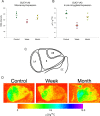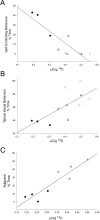Amygdala gene expression correlates of social behavior in monkeys experiencing maternal separation
- PMID: 17376990
- PMCID: PMC6672470
- DOI: 10.1523/JNEUROSCI.4765-06.2007
Amygdala gene expression correlates of social behavior in monkeys experiencing maternal separation
Abstract
Children exposed to early parental loss from death or separation carry a greater risk for developing future psychiatric illnesses, such as major depression and anxiety. Monkeys experiencing maternal separation at 1 week of age show fewer social behaviors and an increase in self-comforting behaviors (e.g., thumb sucking) over development, whereas in contrast, monkeys experiencing maternal separation at 1 month of age show increased seeking of social comfort later in life. We sought to identify neural systems that may underlie these stress-induced behavioral changes by examining changes in mRNA content in amygdala tissue collected from 1 week separated, 1 month separated, and maternally reared infants at 3 months of age. mRNA from the right medial temporal lobe, primarily the amygdala, was analyzed using Affymetrix U133A 2.0 arrays. One gene, guanylate cyclase 1 alpha 3 (GUCY1A3), showed differential expression between the 1 week and maternally reared groups and the 1 week and 1 month groups; these changes were confirmed by in situ hybridization. The expression of this gene was positively correlated with acute social-comforting behavior (r = 0.923; p = 0.001) and longer-term close social behavior (r = 0.708; p = 0.015) and negatively correlated with self-comforting behaviors (r = -0.88; p < 0.001). Additional in situ hybridization studies of GUCY1A3 in normal monkeys showed that this gene is expressed at adult levels by 1 week of age and that its expression is greater in the amygdala than all other brain areas examined. We conclude that GUCY1A3 may contribute to the altered behavioral phenotypes that are differentially displayed depending on the age at which macaque infants experience an early-life stress.
Figures





References
-
- Agid O, Shapira B, Zislin J, Ritsner M, Hanin B, Murad H, Troudart T, Bloch M, Heresco-Levy U, Lerer B. Environment and vulnerability to major psychiatric illness: a case control study of early parental loss in major depression, bipolar disorder and schizophrenia. Mol Psychiatry. 1999;4:163–172. - PubMed
-
- Ahern GP, Klyachko VA, Jackson MB. cGMP and S-nitrosylation: two routes for modulation of neuronal excitability by NO. Trends Neurosci. 2002;25:510–517. - PubMed
-
- Amaral DG. The amygdala, social behavior, and danger detection. Ann NY Acad Sci. 2003;1000:337–347. - PubMed
-
- Baron-Cohen S, Ring HA, Bullmore ET, Wheelwright S, Ashwin C, Williams SC. The amygdala theory of autism. Neurosci Biobehav Rev. 2000;24:355–364. - PubMed
-
- Bauman MD, Lavenex P, Mason WA, Capitanio JP, Amaral DG. The development of social behavior following neonatal amygdala lesions in rhesus monkeys. J Cogn Neurosci. 2004;16:1388–1411. - PubMed
Publication types
MeSH terms
Substances
Grants and funding
LinkOut - more resources
Full Text Sources
